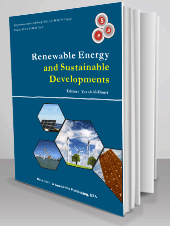Scientific & Academic Publishing
SAP is an open access publisher of journals covering a wide range of academic disciplines.
SAP is an open access publisher of journals covering a wide range of academic disciplines.

Description
The twelve review chapters are collected including properties and applications researches in addition to one important feature: these chapters have presented results obtained from different research groups. The principal objectives are exchanging the information about the fundamental and applied research developments in the area of Renewable Energy and Sustainable Developments. In recent years, the nanoscience has successfully contributed too many interdisciplinary fields. Therefore, transfer of ideas, methods and tools from traditional to nanoscale should be a promising endeavor.
An additional objective is to increase the understanding of the fundamental principles that underlies the problems of nano in the life realms. This is of great relevance to the society and science, in particular for economic endeavors. Objective assessment of risk and quantitative representations of information that support decisions has a vital role to play in many other areas.
The chapters are devoted to thin films and nanostructures principles and applications studies in the field of book title. Chapter one is focused on the nano and micro structures of bismuth oxide thin films preparation by reactive Q-switching pulsed laser deposition was studied using 9 nsec and 1.06 μm of Nd-YAG laser as an ablating tool for Bi target under the O2 environment on silicon and glass substrates. The optimum conditions are based on different laser fluence, oxygen back ground pressure and substrate temperatures for device preparation, followed by chapter two as devoted to nanocrystalline zinc oxide (ZnO) seeded catalyst layer thin films deposited on glass substrates using a sonicated sol-gel method method at various sol concentrations. To obtain desirable piezoelectric properties, X-ray diffraction analyses were used to investigate the effect of sol concentrations on the crystallinity of the films. Where showed as increasing in sol concentration, the value of the full-width at half-maximum of the (002) peak decreases while the stress initially decreases and then increases. Thin films deposited at high concentrations result in an increase in crystallite size. The 0.4 M ZnO thin films exhibited lower stress/strain than other films. The lowest stress value was achieved at the highest crystallinity value. Experimental results show that sol concentration has the greatest influence on the crystallinity of the ZnO thin films. A higher degree of crystallinity and large surface area availability was observed for the ZnO nanorod layer compared to the seeded catalyst layer. While, Three-level single phase transformerless photovoltaic inverter (TPVI) is proposed to minimize the current total harmonic distortion (CTHD). The maximum voltage angle will effect on the current total harmonic distortion, the lowest CTHD of 15.448% is obtained when the maximum voltage angle is 134o is presented in chapter three. Also, a dye-sensitized solar cell (DSSC) consists of a pair of glass substrate with transparent conducting oxide (in this case the Indium Tin Oxide or ITO glass), a non toxic nano porous TiO2 coating which acts as a photo-electrode, sensitizer from dye molecules soaked in the TiO2 film, redox electrolyte layer and a counter electrode catalyst. Due to their excellent potential to deliver solar electric power at very low cost, the DSSC are referred to as the third generation photovoltaic. This chapter four is focused on the usage of organic substances from fruits and vegetable as a potential dye sensitizer. Fruits such as the Pitaya (Dragon fruit), Keriang’s fruit, Black plum skin, Mangosteen pericarp, Rose syrup and Chlorophyll extracted from Spinach are applied as sensitizer to the fabricated DSSC using the conventional method of oxide electrode smearing method, otherwise knows as the Doctor Blading method. Result shows that the photoelectrochemical performance of the DSCs based on these dyes showed that the Voc ranged from 0.432 to 0.787 V, and Jsc was in the range of 0.88 to 2.19mA/cm2. The DSC sensitized by Pitaya extract offered the highest conversion efficency of 1.02% among the six extracts. The photoelectrochemical performance of DSSC and the usage of natural sensitizer demonstrate good potential as a sensitizer yet further studies are needed to enhance the DSSC solar cell efficiency…
Table of Contents
Preface
Chapter 1: Physical Properties of Bismuth Oxide Nano and Microstructures for Optoelectronic Applications
Chapter 2: Crystallographic Orientation of ZnO Nanorod Array Thin Films
Chapter 3: Three-Level Single Phase Transformerless Photovoltaic Inverter
Chapter 4: A Simple Fabrication of Dye Sensitized Solar Cell Using Organic Sensitizer
Chapter 5: Multiwall Carbon Nanotubes in Semiconducting Conjugated Polymer Based Organic Solar Cells
Chapter 6: Magnesium Oxides as a Transparent Dielectric Material for MOS Device Fabrication
Chapter 7: Neural Networks Applications in Bioprocess Control
Chapter 8: A Mini Review on Titanium Dioxide Photocatalyst: Nano-Crystalline and Nano-Tubular Systems in Solar-Driven Water Electrolysis Application
Chapter 9: Aluminium Doped Zinc Oxide Nanorod Array Ultraviolet Photoconductive Sensors
Chapter 10: Nanogap Electrodes: Fabrication Techniques and Applications
Chapter 11: Opportunities in Utilization of Lignocellulosic Biomass Oil to Bio-Esters
Chapter 12: Functionalized Carbon Nanotubes: Enhanced Direct Electron Transfer in Electrochemical Sensors
Index